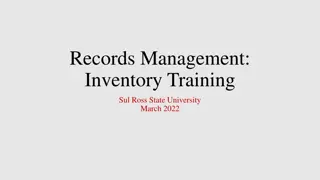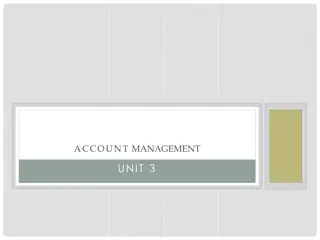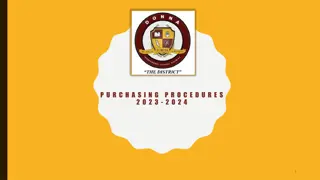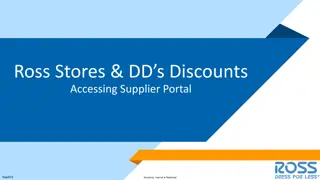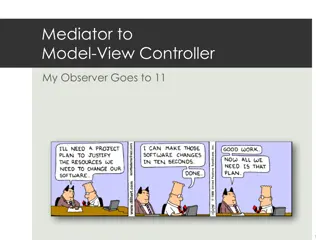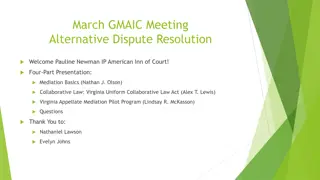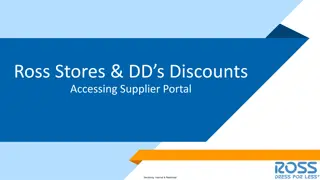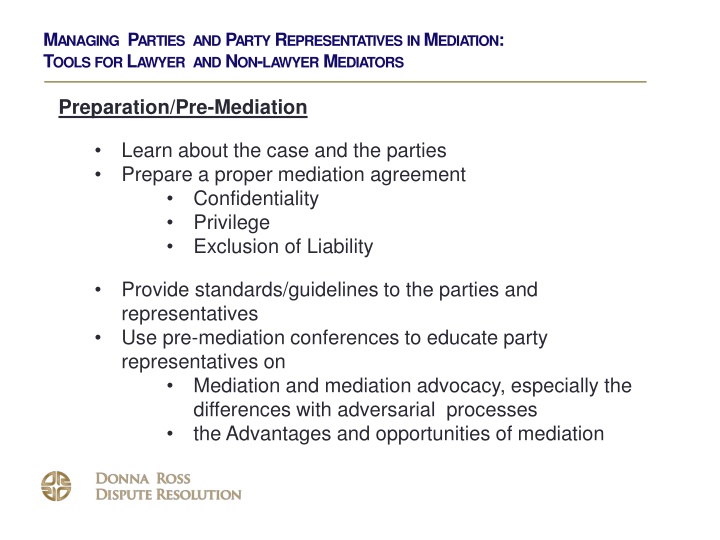
Effective Tools for Managing Parties and Party Representatives in Mediation
Learn about the essential tools for lawyer and non-lawyer mediators to effectively manage parties and representatives in mediation. From preparation to addressing issues during the session, discover key strategies and practices to ensure successful mediation outcomes.
Download Presentation

Please find below an Image/Link to download the presentation.
The content on the website is provided AS IS for your information and personal use only. It may not be sold, licensed, or shared on other websites without obtaining consent from the author. If you encounter any issues during the download, it is possible that the publisher has removed the file from their server.
You are allowed to download the files provided on this website for personal or commercial use, subject to the condition that they are used lawfully. All files are the property of their respective owners.
The content on the website is provided AS IS for your information and personal use only. It may not be sold, licensed, or shared on other websites without obtaining consent from the author.
E N D
Presentation Transcript
MANAGING PARTIES AND PARTYREPRESENTATIVES INMEDIATION: TOOLS FORLAWYER AND NON-LAWYER MEDIATORS Preparation/Pre-Mediation Learn about the case and the parties Prepare a proper mediation agreement Confidentiality Privilege Exclusion of Liability Provide standards/guidelines to the parties and representatives Use pre-mediation conferences to educate party representatives on Mediation and mediation advocacy, especially the differences with adversarial processes the Advantages and opportunities of mediation
MANAGING PARTIESAND PARTY REPRESENTATIVESIN MEDIATION: TOOLSFOR LAWYERAND NON-LAWYER MEDIATORS Request that the advocates prepare for mediation by preparing their clients, managing expectations and identifying potential: Impasses Options Areas of agreement BATNA And that they be ready to problem-solve, not litigate, by: Working with the other side Focusing on interests Keeping an open mind And allowing the client to participate actively
MANAGING PARTIESAND PARTY REPRESENTATIVESIN MEDIATION: TOOLSFOR LAWYERAND NON-LAWYER MEDIATORS Recognizing and Dealing with Advocate Negotiator Types Competing Collaborating Compromising Avoiding Accommodating Use URY & Fisher models to deal with these types: Ask Questions Reframe Go to the balcony Build golden bridge Bring the representatives to do the same with the other party.
MANAGING PARTIESAND PARTY REPRESENTATIVESIN MEDIATION: TOOLSFOR LAWYERAND NON-LAWYER MEDIATORS Issues during the Mediation Session Power imbalance - Especially when only one party is represented Non-lawyer support person doesn t understand role Unprofessional conduct Misleading conduct beyond puffery Refuses to let clients speak Disagreement between lawyer and client Making insulting offers Using the mediation as a litigation tool Wanting to WIN at all costs Trying to settle at all costs
MANAGING PARTIESAND PARTY REPRESENTATIVESIN MEDIATION: TOOLSFOR LAWYERAND NON-LAWYER MEDIATORS Tools Remind participants of their initial agreement Reality test, use BATNA Take a break Bring the discussion back to interests Separate the lawyers Separate the parties
MANAGING PARTIESAND PARTY REPRESENTATIVESIN MEDIATION: TOOLSFOR LAWYERAND NON-LAWYER MEDIATORS Remind the Advocate of His or Her Duties Duty to the Court Duty to the general administration of justice Duty to clients The duty of honesty, courtesy and fairness to other parties. Law Council of Australia Guidelines for Lawyers in Mediations (2007) Assist clients Provide practical and legal advice on the process and on issues raised and offers made Act in good faith to attempt to achieve settlement of the dispute.
MANAGING PARTIESAND PARTY REPRESENTATIVESIN MEDIATION: TOOLSFOR LAWYERAND NON-LAWYER MEDIATORS Avoid being too Directive Avoid giving legal advice Don t press parties to reach a settlement if they need more time, even if a party reneges after agreeing Encourage the parties to remain in contact even if there is no settlement Follow up regularly
MANAGING PARTIESAND PARTY REPRESENTATIVESIN MEDIATION: TOOLSFOR LAWYERAND NON-LAWYER MEDIATORS Thank Thank you for your you for your attention. attention.


